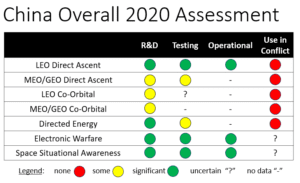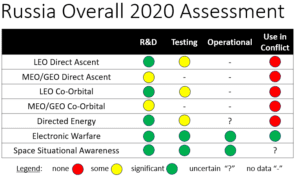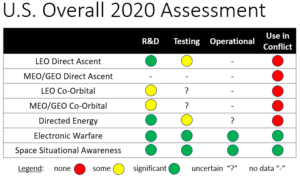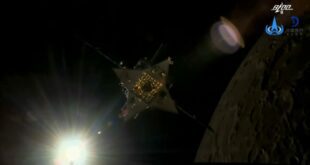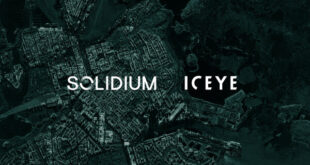Dr. Brian Weeden and Ms. Victoria Samson, Editors
 SpaceWatch.Global is proud to republish this excerpt from the 2020 edition of Secure World Foundation’s Global Counterspace Capabilities: An Open Source Assessment, edited by Dr. Brian Weeden and Ms. Victoria Samson.
SpaceWatch.Global is proud to republish this excerpt from the 2020 edition of Secure World Foundation’s Global Counterspace Capabilities: An Open Source Assessment, edited by Dr. Brian Weeden and Ms. Victoria Samson.
The space domain is undergoing a significant set of changes. A growing number of countries and commercial actors are getting involved in space, resulting in more innovation and benefits on Earth, but also more congestion and competition in space. From a security perspective, an increasing number of countries are looking to use space to enhance their military capabilities and national security. The growing use of, and reliance on, space for national security has also led more countries to look at developing their own counterspace capabilities that can be used to deceive, disrupt, deny, degrade, or destroy space systems.
The existence of counterspace capabilities is not new, but the circumstances surrounding them are. Today there are increased incentives for development, and potential use, of offensive counterspace capabilities. There are also greater potential consequences from their widespread use that could have global repercussions well beyond the military, as huge parts of the global economy and society are increasing reliant on space applications.
This report compiles and assesses publicly available information on the counterspace capabilities being developed by multiple countries across five categories: direct-ascent, co-orbital, electronic warfare, directed energy, and cyber. It assesses the current and near-term future capabilities for each country, along with their potential military utility. The evidence shows significant research and development of a broad range of kinetic (i.e. destructive) and non-kinetic counterspace capabilities in multiple countries. However, only non-kinetic capabilities are actively being used in current military operations. The following provides a more detailed summary of each country’s capabilities.
China
The evidence strongly indicates that China has a sustained effort to develop a broad range of counterspace capabilities. China has conducted multiple tests of technologies for rendezvous and proximity operations (RPO) in both low earth orbit (LEO) and geosynchronous orbit (GEO) that could lead to a co- orbital ASAT capability. However, as of yet, the public evidence indicates they have not conducted an actual destructive co-orbital intercept of a target, and there is no public proof that these RPO technologies are definitively being developed for counterspace use as opposed to intelligence gathering or other purposes.
China has at least one, and possibly as many as three, programs underway to develop direct ascent anti- satellite (DA-ASAT) capabilities, either as dedicated counterspace systems or as midcourse missile defense systems that could provide counterspace capabilities. China has engaged in multiple, progressive tests of these capabilities since 2005, indicating a serious and sustained organizational effort. Chinese DA-ASAT capability against LEO targets is likely mature and likely operationally fielded on mobile launchers. Chinese DA-ASAT capability against deep space targets – both medium Earth Orbit (MEO) and GEO – is likely still in the experimental or development phase, and there is not sufficient evidence to conclude whether there is an intent to develop it as an operational capability in the future.
China likely has sophisticated capabilities for jamming or spoofing space-based positioning, navigation, and timing (PNT) capabilities. There are multiple open source reports of Chinese military PNT jammers being deployed on islands in the South China Sea as well as reports of sophisticated, widespread spoofing of civil GPS signals near the port of Shanghai.
China is likely to be developing directed energy weapons (DEW) for counterspace use, although public details are scarce. There is strong evidence of dedicated research and development and reports of testing at three different locations, but limited details on the operational status and maturity of any fielded capabilities.
China is developing a sophisticated network of ground- based optical telescopes and radars for detecting, tracking, and characterizing space objects as part of its space situational awareness (SSA) capabilities. Like the United States and Russia, several of the Chinese SSA radars also serve missile warning functions. While China lacks an extensive network of SSA tracking assets outside its borders, it does have a fleet of tracking ships and is developing relationships with countries that may host future sensors. Since 2010, China has deployed several satellites capable of conducting RPO on orbit, which likely aid in its ability to characterize and collect intelligence on foreign satellites.
Although official Chinese statements on space warfare and weapons have remained consistently aligned to the peaceful purposes of outer space, privately they have become more nuanced. China has recently designated space as a military domain, and military writings state that the goal of space warfare and operations is to achieve space superiority using offensive and defensive means in connection with their broader strategic focus on asymmetric cost imposition, access denial, and information dominance. China has recently re-organized its space and counterspace forces, as part of a larger military re-organization, and placed them in a new major force structure that also has control over electronic warfare and cyber. That said, it is uncertain whether China would fully utilize its offensive counterspace capabilities in a future conflict or whether the goal is to use them as a deterrent against U.S. aggression. There is no public evidence of China actively using counterspace capabilities in current military operations.
Russia
There is strong evidence that Russia has embarked on a set of programs over the last decade to regain many of its Cold War-era counterspace capabilities. Since 2010, Russia has been testing technologies for RPO in both LEO and GEO that could lead to or support a co-orbital ASAT capability. Evidence suggests at least two active programs: a new co-orbital ASAT program called Burevestnik that is potentially supported by a surveillance and tracking program called Nivelir. The technologies developed by these programs could also be used for non-aggressive applications, including surveilling and inspecting foreign satellites, and the on-orbit testing done to date does not conclusively prove they are for an ASAT program. However, the high-velocity deployment of sub-satellites and multiple releases of orbital debris suggests at least some of the LEO activities are of a weapons nature.
Russia is almost certainly capable of some limited DA- ASAT operations, but likely not yet on a sufficient scale or at sufficient altitude to pose a critical threat to U.S. space assets. While Russia is actively testing what appears to be a new DA-ASAT capability, it is not yet operational and does not appear to have the capability to threaten targets beyond LEO. Russia appears highly motivated to continue development efforts even where military utility is questionable, due at least in part to bureaucratic pressures.
Russia places a high priority on integrating electronic warfare (EW) into military operations and has been investing heavily in modernizing this capability. Most of the upgrades have focused on multifunction tactical systems whose counterspace capability is limited to jamming of user terminals within tactical ranges. Russia has a multitude of systems that can jam GPS receivers within a local area, potentially interfering with the guidance systems of unmanned aerial vehicles (UAVs), guided missiles, and precision guided munitions, but has no publicly known capability to interfere with the GPS satellites themselves using radiofrequency interference. The Russian Army fields several types of mobile EW systems, some of which can jam specific satellite communications user terminals within tactical ranges. Russia can likely jam communications satellites uplinks over a wide area from fixed ground stations facilities. Russia has operational experience in the use of counterspace EW capabilities from recent military campaigns, as well as use in Russia for protecting strategic locations and VIPs. New evidence suggests Russia may be developing high-powered space-based EW platforms to augment its existing ground-based platforms.
Russia has a strong technological knowledge base in directed energy physics and is developing a number of military applications for laser systems in a variety of environments. Russia has revived, and continues to evolve, a legacy program whose goal is develop an aircraft-borne laser system for targeting the optical sensors of imagery reconnaissance satellites, although there is no indication that an operational capability has been yet achieved. Although not their intended purpose, Russian ground-based satellite laser ranging (SLR) facilities could be used to dazzle the sensors of optical imagery satellites. There is no indication that Russia is developing, or intending to develop, high power space-based laser weapons.
Russia has sophisticated SSA capabilities that are likely second only to the United States. Russian SSA capabilities date to the Cold War and leverage significant infrastructure originally developed for missile warning and missile defense. Although some of these capabilities atrophied after the fall of the Soviet Union, Russia has engaged in several modernization efforts since the early 2000s to reinvigorate them. While the government-owned and-operated SSA capabilities are limited to the geographic boundaries of the former Soviet Union, Russia is engaging in international civil and scientific cooperative efforts that likely give it access to data from SSA sensors around the globe. Today, Russia is able to maintain a catalog of Earth-orbiting space objects in LEO that is somewhat smaller than that of the United States but has a slightly more robust catalog of HEO and GEO objects.
Russian military thinkers see modern warfare as a struggle over information dominance and net-centric operations that can often take place in domains without clear boundaries and contiguous operating areas. To meet the challenge posed by the space-aspect of modern warfare, Russia is pursuing lofty goals of incorporating EW capabilities throughout its military to both protect its own space-enabled capabilities and degrade or deny those capabilities to its adversary. In space, Russia is seeking to mitigate the superiority of U.S. space assets by fielding a number of ground-, air-, and space-based offensive capabilities. Russia has recently re-organized its military space forces into a new organization that combines space, air defense, and missile defense capabilities. Although technical challenges remain, the Russian leadership has indicated that Russia will continue to seek parity with the United States in space.
The United States
The United States has conducted multiple tests of technologies for RPO in both LEO and GEO, along with tracking, targeting, and intercept technologies that could lead to a co-orbital ASAT capability. These tests and demonstrations were conducted for other non-offensive missions, such as missile defense, on-orbit inspections, and satellite servicing, and the United States does not have an acknowledged program to develop co-orbital capabilities. However, the United States possesses the technological capability to develop a co-orbital capability in a short period of time if it chooses to.
While the United States does not have an operational, acknowledged DA-ASAT capability, it does have operational midcourse missile defense interceptors that have been demonstrated in an ASAT role against low LEO satellites. The United States has developed dedicated DA-ASATs in the past, both conventional and nuclear-tipped, and likely possesses the ability to do so in the near future should it choose so.
The United States has an operational EW counterspace system, the Counter Communications System (CCS), which can be deployed globally to provide uplink jamming capability against geostationary communications satellites.
Through its Navigation Warfare program, the United States has the capability to jam global the civil signals of global navigation satellite services (GPS, GLONASS, Beidou) within a local area of operation to prevent their effective use by adversaries and has demonstrated doing so in several military exercises. The United States is likely has the ability to jam military GNSS signals as well, although the effectiveness is difficult to assess based on publicly available information. The effectiveness of U.S. measures to counter adversarial jamming and spoofing operations against military GPS signals is not known.
The United States currently possesses the most robust SSA capabilities in the world, particularly for military applications. American SSA capabilities date to the beginning of the Cold War and leverage significant infrastructure developed for missile warning and missile defense. The core of its SSA capabilities is a robust, geographically dispersed network of ground-based radars and telescope sand space-based telescopes. The United States is investing heavily in upgrading its SSA capabilities by deploying new radars and telescopes in the Southern Hemisphere, upgrading existing sensors, and signing SSA data sharing agreements with other countries and satellite operators. The United States still faces challenges in modernizing the software and computer systems used to conduct SSA analysis and is increasingly looking to leverage commercial capabilities.
The United States has had established doctrine and policy on counterspace capabilities for several decades, although not always publicly expressed. Most U.S. presidential administrations since the 1960s have directed or authorized research and development of counterspace capabilities, and in some cases greenlit testing or operational deployment of counterspace systems. These capabilities have typically been limited in scope, and designed to counter a specific military threat, rather than be used as a broad coercive or deterrent threat. The U.S. military doctrine for space control includes defensive space control (DSC), offensive space control (OSC), and is supported by space situational awareness (SSA).
The United States is undergoing a major reorganization of its military space activities as part of a renewed focus on space as a warfighting domain. Since 2014, U.S. policymakers have placed increased focus on space security, and have increasingly talked publicly about preparing for a potential “war in space.” This rhetoric has been accompanied by a renewed focus on reorganizing national security space structures and increasing the resilience of space systems. This has culminated in the reestablishment of U.S. Space Command and the creation of the U.S. Space Force, which assumed the responsibilities of U.S. Strategic Command for space warfighting and Air Force Space Command for operating, training, and equipping of space forces, respectively. To date, the mission of these new organizations is a continuation of previous military space missions, although some have advocated for expanding their focus to include cislunar activities and space-to-ground weapons. It is possible that the United States has also begun development of new offensive counterspace capabilities, although there is no publicly available policy or budget direction to do so. There are recent budget proposals to conduct research and development of space-based missile defense interceptors and DEW that could have latent counterspace capabilities. The United States also continues to hold annual space wargames and exercises that increasingly involve close allies and commercial partners.
The entire SWF Global Counterspace Capabilities report can be read here.
This excerpt is republished here with the kind permission of the Secure World Foundation.
 SpaceWatch.Global An independent perspective on space
SpaceWatch.Global An independent perspective on space

